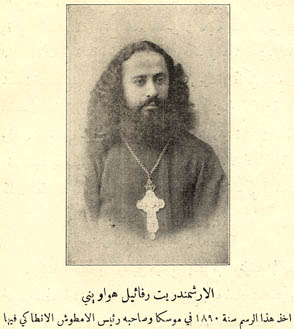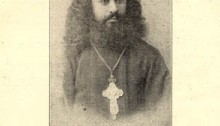
Since 1848, the Patriarchate of Antioch has had a “metochion,” or representation church (basically an church embassy) in Moscow. Immediately before he came to America, St. Raphael Hawaweeny served as head of the metochion. Earlier this year, the must-read blog Notes on Arab Orthodoxy published a brief history of the metochion and an interview with its current head, Archbishop Niphon. We’ve been given permission to reprint the history part of the article here. To read the whole thing, including the interview with Archbishop Niphon, CLICK HERE.
There appears in a marginal comment in a Euchologion, “Patriarch Methodius, along with the metropolitan of Beirut and the metropolitan of Akkar visited Balamand Monastery and consecrated Neophytos for the country around Baalbek on Wednesday, August 12, 1842.”
After Catholic and Protestant teaching and missionary activities in diocese of the Antiochian See expanded and Patriarch Methodius did not see in the Three Holy Hierarchs School that he had founded in Beirut something that would fend off the danger, he contacted Russian intermediaries. They asked him to send a bishop to tour their country and collect funds to repair churches, establish schools and publish books. In 1842, he sent Metropolitan Neophytos of Baalbek, along with Archimandrite Sophronius, the hieromonk Anthimus, and his secretary, Youhanna Papadopolou. In the patriarchal message, it stated that the Antiochian Church had long suffered from poverty and humiliation and so was surrounded by dangers coming from the Catholics who were spreading their doctrines, taking the best churches and monasteries and plundering houses of worship, which became empty as the faithful were languishing on the threshold of ignorance. That which they would collect from the Russian faithful would be consecrated for establishing schools and printing-presses and repairing the Church of Saint Nicholas in Damascus, along with other churches and monasteries. This statement was signed by Patriarch Methodios and Metropolitans Methodius (Homs), Benjamin (Beirut), Ioannikius (Tripoli), Armimius (Lattakia), Zachariah (Irqah), Barnabas (Hama), Jacob (Seleucia) and Isaiah (Tyre and Sidon). The Antiochian Church enjoyed the sympathy of Russian government and people.
When Metropolitan Neophytos Halabi of Baalbek arrived in Moscow in 1842, he was welcomed by Metropolitan Filaret of Moscow, who greatly loved the entire Orthodox Church. He asked that the Church of the Ascention and Saint Hypatius, in Moscow near the Kremlin, be given to the See of Antioch and the Synod accepted this. The decision was brought to the czar and it gained acceptance on December 22, 1848. The following year the church, along with all its possessions and properties was handed over to the See of Antioch for he building of a patriarchal metochion in Moscow. The Holy Synod of Russia stipulated that the income of this metochion be used for educating the Antiochian clergy and laity. Metropolitan Neophytos purchased a house near the metochion from his personal funds and in turn sent everything that the metochion received to the See of Antioch. He remained head of the metochion for five years and died and was buried in Moscow in 1853, leaving behind twenty thousand rubles. According to his wishes, this money was put in the bank and its procedes were sent to the See of Antioch to be spent on schools.
After Neophytos, the metochion was headed by Archimandrite Anthimus. In 1862, Patriarch Hierotheus of Antioch named Archimandrite Ghufrail Shatila as head of the metochion. After he was elected, it was headed by Metropolitan Cyril of Palmyra, but he fell ill and returned to Damascus where he died. Despite this, Cyril sent enormous sums of money for the renovation of the Church of Saints Peter and Paul in Antioch.
Leadership of the metochion was subsequently held by a Father Isaias and some Russian monks, until 1879, when the patriarch of Antioch named Archimandrite Christopher Jabbara, a Damascus native, as head. He increased the metochion’s income and erected numerous buildings with the help of Metropolitan Makarii of Moscow. In 1887 the patriarch of Antioch recalled him and until 1889 the metochion was led by the priest Nikon, followed by Archimandrite Raphael Hawaweeny.
In 1900, Patriarch Meletius Doumani appointed the priest Alexander Tahhan who, on April 7, 1902 was elevated to the rank of archimandrite. His accomplishments included improvements to the metochion’s building as well as the addition of storehouses and houses. After his election as metropolitan of Cilicia, Archimandrite Ignatius Abu el-Rus was appointed in 1903 and afterward Archimandrite Antonius Mubayyed, until 1920.
For political reasons, from 1920 until 1948 management of the metochion was handed over to the Russian Church and at the end of 1948 it was returned to the Antiochian Church by Patriarch Alexei I of Russia. Leaders of the metochion included Metropolitan Basilius Samaha (Metropolitan of Bostra, Hawran and Jebel el-Arab 1962-1999) and Metropolitan Alexi Abd el-Karim (Metropolitan of Homs 1963-1999).
CLICK HERE to read the rest of this article at Notes on Arab Orthodoxy.

Leave a Reply